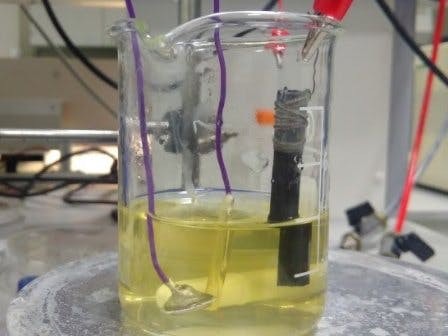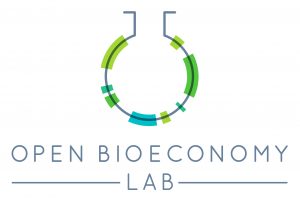Low Cost Oxygen Sensor for Bioreactors
Bacterial cultures, especially in bulk quantities must be closely monitored to grow in optimal conditions. These conditions include temperature, pH and oxygenation.
Previous projects have effectively tackled the first two components of this system, but the dissolved oxygen sensing has remained an issue not only in the biomaker challenge-inspired bioreactor but in comparable initiatives as well.
In this project, Open Bioeconomy Lab team members, Chiara Gandini, Anne-Pia Marty and Joseph Wong (PhD Student, Department of Chemical Engineering and Biotechnology, University of Cambridge) built a low-cost oxygen sensor for bacterial cultures using a gold wire as a cathode to record current from the oxidation process. A potentiostat controls the polarization of the electrode. The sensor is a cheap, open source device that can be sterilized. The sensor is able to record the dissolved oxygen in a batch E. coli culture in a bioreactor.

The electrode system
The oxygen concentration in the culture medium can be measured electrochemically and continuously for at least 24 hours. Gold is the choice of working electrode because it is a stable and inert material to electrochemically reduce oxygen. Gold wire encased in epoxy is the working electrode. It has a fine opening at one end exposing the cross-section of the gold wire to the electrolyte. The opening is protected by an oxygen permeable membrane resistant to cell attachment and protein aggregation. PTFE and cellulose membrane (dialysis membrane) will be investigated for their applicability to the current set-up. PTFE is cheap, hydrophobic and oxygen permeable while dialysis membrane have different pore sizes to give different diffusivity for different sizes of molecules. The selectively permeable membrane is held at the opening with an O-ring encapsulating a small volume of electrolyte. A silver rod is the reference electrode placed in proximity to the working electrode. The current generated by oxygen reduction reaction will be recorded and used to calculate the bulk oxygen concentration. (Fig. 1 and 2)
Figure 1: Schematic of the device. The gold wire encased in an epoxy coating and open at the end to a membrane. This sensor is placed close to a silver reference sensor.
Figure 2: Another approach of the device, similar to figure 1 but where the O2 electrode and reference sensor are both in the same casing with the membrane acting as a buffer for the both of them.
The potentiostat
The second objective of the project was to develop a cheap small-scaled potentiostat. A potentiostat is highly important for controlling electrode polarization and measuring the current output which correlates to dissolved oxygen concentration. Using an op-amp and few electronics could create a simplified version of potentiostat (fig. 3).
Figure 3: Basic schematics of a Potentiostat By Enseeg – Own work, CC BY-SA 3.0, https://commons.wikimedia.org/w/index.php?curid=4248644 [6]
Oxygen concentration can thus be measured and calculated in real-time by Arduino which can execute the subsequent actions (e.g. introduce additional feeding). A touchscreen user-friendly interface was set up and programmed for easy control of functions (e.g. calibration and oxygen measurement) and displaying oxygen concentration in real-time.
Outcomes and benefits
The expected outcome of the complete project is the implementation of an open-source low-cost oxygen sensor module that will serve to measure dissolved oxygen in E. coli cultures. The hardware will be open source and the documentation will include software and protocols for calibration and usage.
Future directions for this project would be to link the data output to a feedback loop and add additional feeds to increase the yield in the bioreactor.
For the full story go to https://www.hackster.io/biomaker/low-cost-oxygen-sensor-for-bioreactors-c7e066

